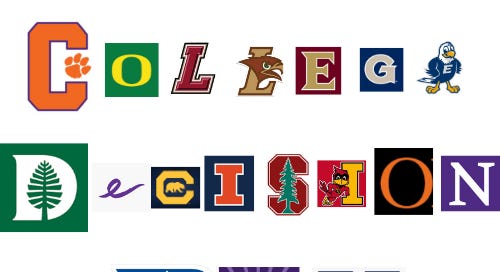Admission Trends, Waitlists and the May 1st Countdown.
Insights into the application cycle for the Class of 2029, what to do if your child was waitlisted and the May 1st countdown.
College admissions is always shifting— which keeps my job interesting (and secure!). Each year, we take a step back to make sense of the decisions and try to understand the bigger picture behind the outcomes.
Two weeks ago was Ivy Day. A day where kids with 1600s on the SAT and 4.5 GPAs are denied and left wondering what more they could have done. It’s a clear reminder of how unpredictable college admissions can be— sometimes even a perfect score isn’t enough.
But then you have wins that totally make your day— like the first-gen student I got to work with who is now off to Yale! His journey was seriously inspiring, pure resilience. Those are the moments you really celebrate.
College admissions can feel like a black box sometimes, but we're always learning. By looking at each year's results, we can definitely pick up on some clues about what might be important in the future.
Admission Trends for the Class of 2029 (current high school seniors)
Regional shifts in applications: Notably, the Southwest has witnessed an extraordinary surge in applications, with an impressive 34% increase this year. Texas is leading this charge with a 37% jump in applications. [Common App trends]
A strong narrative is more important than ever for competitive majors such as Engineering, Business, Computer Science, Architecture, Biology and Nursing. Showing evidence of experience, interest and connection to a field is paramount.
An 11% growth in test score (SAT & ACT) submissions. However, test optional is still very much an option as evidenced by FairTest. [Common App trends]
The Class of 2029 was the first class to have ChatGPT at their fingertips, the first class not to be in high school during “peak Covid times” and the first class to take the new Digital SAT (dSAT).
Waitlists 101
For students who find themselves on a waitlist, it's important to understand the process. The first thing to do is check out the waitlist numbers from the previous application year through the school’s Common Data Set (CDS). Take Tulane for instance. Last year, 4,192 students were offered a spot on the waitlist. Of those, 432 were ultimately admitted. Waitlist data is fascinating to look at and should be viewed very carefully.
Once you understand the data, go ahead and accept that spot on the waitlist. If it's your top pick, a quick update email showing you're still interested is smart. But in all reality: waitlists are usually a long shot, more of a "soft no." So, while you wait, pour your energy into the schools that did say yes – those are your wins! It's also important to remember that waitlists operate on a different timeline, often extending until July, which can cause uncertainty for students.
May 1st Countdown
May 1st is National College Decision Day. It’s the deadline for accepted students to formally commit to a college or university they have been accepted to through an enrollment deposit. Every student, even those hoping to get off of a waitlist must enroll somewhere by May 1st. Colleges are watching closely to see their "yield" (how many applicants say yes!), which can get those waitlists moving. For seniors and their families, it's a super exciting time as plans lock in for the next awesome adventure!
The last thing I’ll leave you with is an excerpt from Frank Bruni’s book, Where you Go is Not Who You’ll Be:
“There’s a widespread conviction, spoken and unspoken, that the road to riches is trimmed in Ivy and the reins of power held by those who’ve donned Harvard’s crimson, Yale’s blue and Princeton’s orange, not just on their chests but in their souls. No one told that to the Fortune 500. They’re the American corporations with the highest gross revenues. The list is revised yearly. As I write this paragraph in the summer of 2014, the top ten are, in order, Wal-Mart, Exxon Mobil, Chevron, Berkshire Hathaway, Apple, Phillips 66, General Motors, Ford Motor, General Electric and Valero Energy. And here’s the list, in the same order, of schools where their chief executives got their undergraduate degrees: the University of Arkansas; the University of Texas; the University of California, Davis; the University of Nebraska; Auburn; Texas A&M; the General Motors Institute (now called Kettering University); the University of Kansas; Dartmouth College and the University of Missouri–St. Louis. Just one Ivy League school shows up.”
Helping you soar sooner,
Carrie






